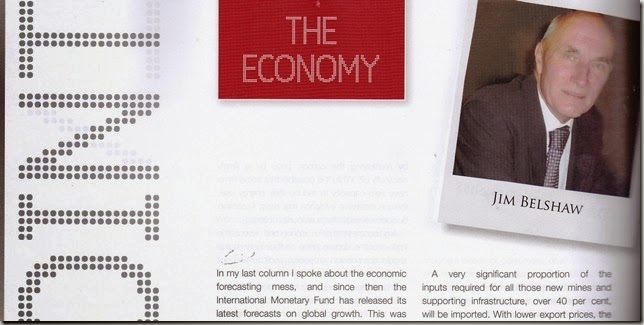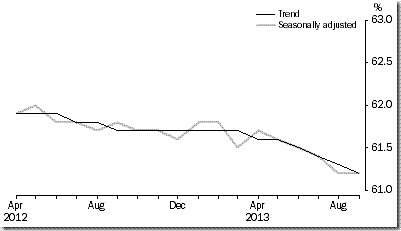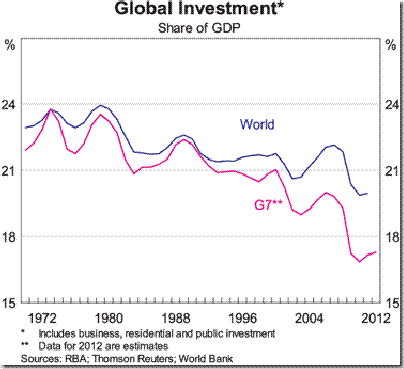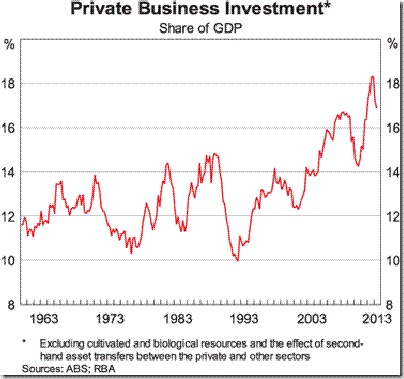 At the start of November, I prepared an economic outlook for 2014 for publication in a business magazine. The piece is not on-line, so it seemed sensible to run it again here with an update, thus testing my assessment in light of the some what topsy turvy changes over two months since I wrote.
At the start of November, I prepared an economic outlook for 2014 for publication in a business magazine. The piece is not on-line, so it seemed sensible to run it again here with an update, thus testing my assessment in light of the some what topsy turvy changes over two months since I wrote.
The piece begins
Twenty thirteen has been a funny old year in economic terms. Globally, the year began with expectations of somewhat greater economic growth, continuing the slow recovery from the great global recession. Pessimism re-emerged as growth was slower than expected, turning again to optimism as growth began to pick up. At the 1 October Monetary Policy Meeting of the Reserve Bank Board, members observed that, on balance, the “data for the global economy had been a bit more positive of late and broadly consistent with growth of Australia’s major trading partners remaining around its long term average.”
How quickly things change! At the time the Board met, the US fiscal and debt crises were looming, but there was still an expectation that they would be resolved. Then came the partial US government shutdown, followed by brinksmanship over the debt ceiling. Debt default was avoided and the US Government re-opened, but with new deadline dates; January 15 2014 for government activity, 7 February for Government borrowings.
The immediate direct effects on the US economy were relatively small, with Standard and Poors estimating that the shutdown had shaved at least 0.6 per cent of the US economy’s annualised growth rate in the December quarter. The impact on confidence and business certainty is likely to have been much greater.
You can get a feel for this from the increasingly concerned comments made by central bankers as the crisis proceeded. “We felt helpless”, the SMH’s Glen Hutchens reports Reserve Bank Governor Glen Stevens as saying. “The Bank could neither predict nor properly prepare for the way the drama might play out”. It wasn’t just the impact on global financial markets that had to be considered, but also a possible forced contraction in US Government spend equivalent to 4 to 5 per cent of US gross domestic product.
Doubts linger, casting a continuing cloud as we move towards 2014. Uncertainty over the ending of quantitative easing and the impact that this might have on markets adds to doubt, as do continuing uncertainties over the Chinese economy. Despite these doubts, I think that 2014 is likely to be a better year in economic terms, far better than some analysts allow.
Comment
The US sorted its fiscal and debt limit problems, at least for immediate purposes. Quantitative easing has begun to end, although in a very tapered way. Both are positive for the economic outlook.
The Importance of Business Confidence
One of the unusual features of the last two years has been the general lack of confidence displayed by Australian business. I say unusual, because the Australian economy has actually performed quite well in global terms. Many international economic commentators have been bemused by this Australian economic gloom, pointing to the divergence between it and the actual performance of the Australian economy.
This first graph prepared by the Reserve Bank illustrates the confidence problem. Business confidence  plunged with the onset of the global financial crisis to levels lower than those holding in the recession of the early 1990s. Business confidence then rebounded sharply as the crisis eased and Australia’s mining boom picked up pace, peaking slightly above the levels holding over the previous decade. Business confidence then began an inexorable decline.
plunged with the onset of the global financial crisis to levels lower than those holding in the recession of the early 1990s. Business confidence then rebounded sharply as the crisis eased and Australia’s mining boom picked up pace, peaking slightly above the levels holding over the previous decade. Business confidence then began an inexorable decline.
Confidence is important, for without it business will neither invest nor employ new people. The progressive decline in business confidence dragged on economic activity, effectively feeding itself. Political uncertainty fed the lack of business confidence, especially in the last period. You can see this in the sudden rebound in business confidence following the election. If sustained, this will encourage increased economic activity, providing a first building block for economic expansion.
Comment
At the time I wrote these words, I did not forsee the instability in Australian Government policy, nor the nature of the debate that would take place in the lead-up to the release of the Mid Year Economic and Fiscal Outlook with its somewhat lower Treasury economic projections, nor the almost forced announcement of Holden's intention to cease manufacturing. This will probably have minimum real economic impact over 2014, but it has damaged confidence.
The swing in economic commentary was quite remarkable. Over a four week period marked by selective leaks on the budget position, the central tone in commentary went from neutral/slightly positive to negative/neutral. It was really quite a remarkable swing that must affect confidence. For the moment, call this one a negative.
Consumers on Strike
Retail sales have been relatively stagnant over the last two years. Effectively, consumers have been on strike. There have been good practical reasons for this. In Australia, as in may other countries, personal debt levels rose during the long period of economic growth, supported in part by rising asset values. Savings rates dropped to very low levels.
This process went into reverse following the global financial crisis and subsequent global recession. People sought to save more, to spend less, to de-leverage, adding to downward economic pressure. The effects were muted in Australia by the mining boom, but persisted nevertheless.
Structural change in the Australian workforce reinforced the process. While workforce flexibility does aid business activity, the growing proportion of the Australian workforce working in contract or casual roles has affected consumer behaviour. Greater work uncertainty requires people to hold larger cash reserves, as do the periodic employment gaps often associated with such work. It also depresses Christmas sales, since a not insignificant proportion of the workforce is now only paid when they work. Christmas is actually a low income period for many people.
Further downward pressure has been added by public sector cuts backs and then, more recently, by cut backs in mining employment as mining companies seek to curtail costs. The combined effect can be  illustrated by the second graph drawn from the Australian Bureau of Statistics showing the employment to population ratio from April 2012 to September 2013. This shows clearly the decline in the proportion of Australians actually employed over the last eighteen months. This decline has been significantly greater than the increase in the unemployment rate because many Australians have dropped out of the workforce.
illustrated by the second graph drawn from the Australian Bureau of Statistics showing the employment to population ratio from April 2012 to September 2013. This shows clearly the decline in the proportion of Australians actually employed over the last eighteen months. This decline has been significantly greater than the increase in the unemployment rate because many Australians have dropped out of the workforce.
In simple terms, there are fewer Australians working, and those who are working are less prepared to spend money.
This is likely to turn round over 2014. The increase in savings and consequent decline in willingness to spend associated with financial de-leveraging, structural change in the workforce and uncertainty about the future has probably peaked, although the effects will linger. Further, the labour force data suggests that there is considerable scope to increase employment without creating new wages pressures. The combination provides the second building block for better economic conditions in 2014.
Comment
I think that consumer confidence was hit by the discussion associated with the Commonwealth Government's budget position and the Holden decision, and all this just before Christmas with retailers dependent on Christmas sales. Talk about timing.
There have been signs of some of weakening in the labour market too, although this is more anecdotal than anything else. This would not be surprising given the changed business mood. However, at this stage my position remains the same.
The Exchange Rate
The Australian dollar is likely to provide the third building block for faster growth. By all measures, the Australian dollar is over-valued, although there is dispute about the exact scale of over-valuation. This has depressed economic activity through lower Australian dollar returns on exports, combined with higher import competition.
So long as quantitative easing remains in force in key countries and especially the US, the dollar is likely to remain over-valued. However, as quantitative easing ends with consequent rises in international interest rates, the Australian dollar will fall. We have already seen how the merest hint of an end to US quantitative easing shifted the value of the dollar down. Quantitative easing will end, although the timing is uncertain and the process likely to be messy.
Australian interest rates will rise over 2014, in part because of the need to avoid or at least minimise an emerging property bubble. However, what is relevant from an exchange rate perspective is the differentials between real interest rates. So long as Australian rates rise less in real terms than interest rates in other key countries, the value of the Australian dollar will fall. This is likely, given that real interest rates in major developed countries are now so low or even negative.
A lower Australian dollar brings benefits, but also costs. We saw this in the September quarter, when the Australian import price index rose by 6.1 per cent, the export price index by 4.2 per cent. Both increases were directly associated with a fall in the value of the Australian currency. The increase in export prices benefits exporters, the rise in import prices aids domestic production but also feeds directly into inflation.
Inflation will rise as the dollar falls. For the present, Australian inflation is quite low, well within the Reserve Bank’s target range. However, it is likely to kick up noticeable over 2014, adding somewhat to interest rate pressures.
Comment
Action in the US to end quantitative easing has begun and the Australian dollar has fallen. The taper actually helps us by minimising the immediate currency flows that might have adversely affected emerging markets. The fall in the value of the Australian dollar has already begun to feed through, including an unexpected but helpful lift in Western Australian Government revenues.
The Reserve Bank has the capacity to cut rates if that is necessary to counter domestic economic weakness, thus further reducing the value of the Australian dollar. However, for the present I hold to my analysis for 2014.
Investment
 In October, Reserve Bank Deputy Governor Phillip Lowe noted in a speech that the developed economies have been in an investment drought since 2008. Investment has also been very low for the world as a whole.
In October, Reserve Bank Deputy Governor Phillip Lowe noted in a speech that the developed economies have been in an investment drought since 2008. Investment has also been very low for the world as a whole.
Graph three illustrates this.
Note the longer term downward trend, as well as the sharp fall since 2008. Note, too, the widening gap between investment in major developed countries and total world investment, a sign of the economic shifts that have been taking place within the global economy.
By contrast, Australian investment has a proportion of GDP has risen quite sharply since 1993.
Graph four presents the dramatic change that has taken place. Australian private business investment peaked at levels not seen since the gold rush and post gold rush periods.
This growth has been almost entirely due to the mining investment boom. Outside mining, private business investment has been quite low, mirroring international patterns.  As a consequence, Australians started talking about a two speed or even patchwork quilt economy.
As a consequence, Australians started talking about a two speed or even patchwork quilt economy.
In many ways these were accurate descriptions, but also missed an important point. Unlike past booms, the cost pressures associated with the mining investment boom were effectively quarantined to mining, leaving the remainder of the economy in a better position to grow.
With the end of the mining investment boom, investment as a proportion of GDP has started to fall, placing downward pressure on economic activity. This has led some analysts including Deloitte Access Economics to talk about investment in quite gloomy terms. I don’t share that view. Indeed, investment is my fourth building block for better economic conditions in 2014. I am not saying that investment will boom, simply that it will be better than expected.
In balance sheet terms, Australian business is well placed to expand investment if conditions suit. Corporate debt levels have been reduced, while liquid assets have risen. Banks, too, are in a position to expand business lending. But will conditions suit? I think that they are likely too.
In October, the Australian Bureau of Statistics released some quite remarkable numbers. The trend estimate for total dwellings approved rose 2.5 per cent in September, up 15.1 per cent from the same month last year, and has been rising for twenty one months. The increase was driven particularly by dwelling units, up 20.9 per cent in trend terms, but private sector houses also rose by a substantial 10.6 per cent.
These statistics are supported by a variety of anecdotal evidence. The property sections in Australian newspapers including the Financial Review are expanding, an expansion not limited to housing. Investment in retailing, office building and industrial estates and rural land are all displaying signs of increased activity.
This expansion is not limited to building. Rising share prices and increased confidence has led to a resurgence of initial public offerings. The markets are moving. Indeed, if you ignored the official economic statistics and the sometimes gloomy commentary based on those statistics and relied only on newspaper reporting, you might be forgiven for concluding that a new boom was well underway! Herein lies a problem, for the Reserve Bank may in fact be forced to move earlier on interest rates than would otherwise be the case in order to control investor exuberance.
Comment
My glasses may have been too rosy here, but for the moment I hold to my position.
The Global Economy
As a trade exposed economy, Australia is affected by economic conditions elsewhere in the world. Here, too, I am more positive than many commentators. Yes, there are some problems. As I have written in my column, China remains a question mark because of the need to rebalance the economy, a process likely to prove messy. The US fiscal cliff and debt ceiling debates still cast a shadow. However, Australia does not need the rest of the world to boom in order to grow. All the country needs at this point is continued global economic growth even if at moderate level. Here the signs are reasonably positive.
The Europeans are slowly dragging themselves out of a recession that, in statistical terms, bears a striking resemblance to the Great Depression. The results have been absolutely awful from a European perspective in human and economic terms, but the immediate likelihood is for slow growth that has the potential to accelerate once properly underway. The US too has been growing despite the best endeavours of US politicians.
My best judgement in all this is that while I see few signs of a rapid acceleration in global economic growth, there will be growth. And that’s all Australia needs at this point.
Comment
Global economic growth and especially US growth has been stronger than expected even two months ago. This building block remains positive.
Conclusion
In writing, I have consciously tried to break from the gloom that sometimes dominates current economic analysis, to set out the reasons why I think that 2014 is likely to be better in economic terms than 2013 so far as Australia is concerned. In so doing, I focused on four building blocks.
The first is business confidence. Low business confidence has been a drag on the Australian economy, but has now resurged. I think it likely that business confidence will remain positive.
The second is consumption. Australian consumers have been on strike, again dragging down the economy, because of both uncertainty and the effects of fundamental strategic change in the workforce. That strike is coming to an end.
The third building block is the exchange rate. The Australian dollar has been overvalued. Over 2014, I expect the value of the Australian dollar to fall. This will have adverse price effects, but the overall impact will be support for domestic economic activity.
My final building block is investment. Yes, the end of the mining investment boom will exert downward economic pressure. However, I do not share the gloom and doom view of some commentators. There is increasing evidence of an investment boom in non-mining areas, a boom that will encourage economic activity in non-mining areas of the Australian economy. In fact, the big economic challenge of 2014 may be to find the best way of managing that boom without depressing the overall economy.
In all, I think that 2014 will be an interesting and potentially profitable year.
Comment
Pollyanna may be speaking, but for the moment, I am prepared to hold my overall assessment,
